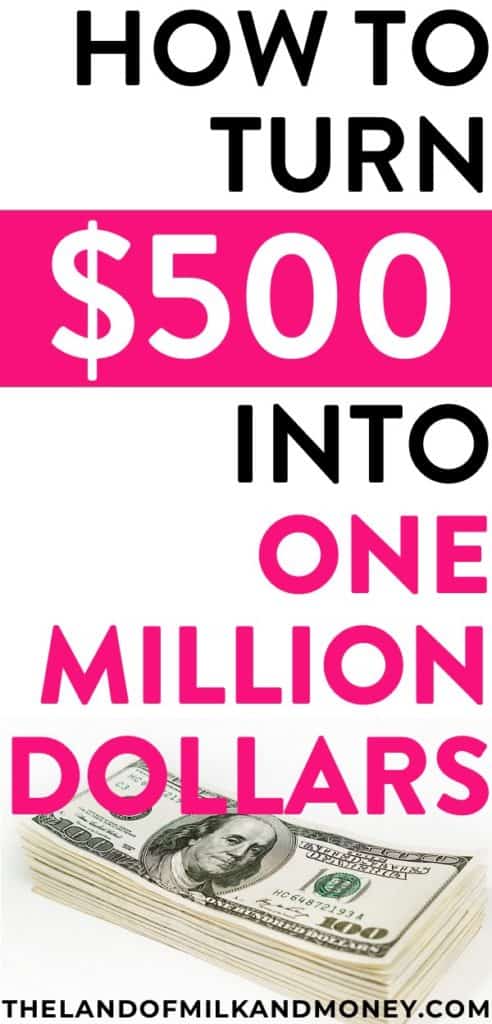The path to early retirement isn’t complicated. It’s not easy, sure, but as with many things in life, the most straightforward option is often the most effective. And if you’re trying to figure out how to retire early, any millionaire will tell you that it all boils down to one simple concept: compound interest.
I’ve mentioned before that there’s no magic trick to becoming financially free – but this is pretty damn close.
And it doesn’t hurt that it’s also the same trick for you to potentially become a millionaire yourself one day!
Check out these related articles:
- The Step-by-Step Guide to Investing Like a Pro
- Check out Step 1: The Beginners’ Guide To Investing Like An Expert (Including How To Beat The Professionals) right here!
- How To Think Like A Future Millionaire
- The Only Tip You Need To Reach Financial Freedom As Soon As Possible
- Financial Freedom Is Totally Achievable. Here’s How
- How Much Money Do I Need To Retire?

How to retire early: The path to financial freedom
Firstly, it should be noted that there are some basic principles for reaching the nirvana of financial freedom. One of them is that you need to earn more than you spend.
Perhaps easier said than done for you, but nowhere near as impossible as you may think, although I’ll go into that in more detail in some later posts.
The second is that your money should work for you.
For example, if you just park all of your savings in a standard bank account, where the interest rate is usually around 1%, you are losing money.
The average annual rate of inflation in the US since 1914 has been just over 3%. As such, if your money is earning less than that in interest, it’s actually losing value.
If your rate of return is, however, more than that, then welcome to the magical world of Earning While Doing Nothing – also known as compound interest.
Earning while doing nothing
Essentially, it’s like this:
You put $10,000 in an investment that earns an annual 7% rate of return. After twelve months, that has become $10,700.
You continue to earn 7%, but now that rate is being earned on the increased amount, meaning at the end of the next year your savings are worth $11,449.
In fact, by doing nothing, after ten years you will have $19,671.51 or almost double your starting amount.
Now imagine that you are adding $10,000 per year to those savings:
That is, for putting in $100,000 over a ten-year period, you will end up with $147,836.
As another way to see it: you will have almost $50,000 extra for doing absolutely nothing.
How about this: keep doing that for thirty years and, for investing $300,000 in total, you will have over $1,000,000.
I know: holy crap.
The magician’s secret
For this part, I’ll need a volunteer: someone (maybe you!) willing to start doing this as soon as possible.
Here’s why: as seen from the thirty year example above, the more time that your money has to work its magic, the better the outcome will be for you.
A perfect way to see this is through the following example:
Hansel and his good friend, Gretel, have just both finished university at the ripe old age of 25 and have scored their first jobs after graduation.
Gretel, being a devout worshiper at the altar of compound interest, manages to save $500 per month or $6,000 per year.
(She should be saving more than this given that it is only a hair over 10% of the current US median income of $59,039, but we can have that discussion another day.)
She invests this from the age of 25 to 35 when she decides to stop working to go and “find herself” (and probably start a blog).
Hansel spends his late twenties and early thirties at the pub, until he wakes up when he’s 35 and realises that things have to change. That’s fine; better late than never, Hansel. At that point, he also starts investing the $500 per month that he saves, or $6,000 annually, for the next thirty years until he retires at age 65.
This is the progress of their respective investments (again, based on an annual rate of return of 7%):
Hansel didn’t do too badly at all, ending up with $606,438 based on investing $180,000. This is equivalent to earning just over $450,000 for doing absolutely nothing.
However, for starting ten years later (and investing an extra $120,000 of his own money), he has $137,531 less than Gretel.
“Pardon?”, I hear you ask.
That’s right: Gretel invested $60,000 and ended up with $771,355, which equates to more than $710,000 for doing zero work.
And if she had continued to invest regularly until retiring at age 65?
Her $500 per month over 40 years at a 7% annual rate of return would have amounted to $1,281,657.42.
Put another way, the $240,000 contributed over her lifetime would have earned over $1,000,000.
(If you’d like to play around with this some more through using your own figures, such as if you’re saving more than the amounts set out here – as we all should be doing! – I recommend using the tool that’s available here.
Watching the final number go up as you increase your annual addition is pretty much my ideal Friday night!)
I want to know how to become a millionaire
Good for you!
I mean that with absolutely zero sarcasm. In fact, that’s exactly the goal that I’m aiming for as well.
How long will it take (and how much do I have to sacrifice)?
Not much at all, actually.
The key, of course, is compound interest.
Let’s look at how long it will take (as above, based on an annual rate of return of 7%) using figures obtained from the calculator on this page:
- If you save $500 per month, you will have $1,000,000 in 36.3 years
- If you save $1,000 per month, you will have $1,000,000 in 27.5 years
- If you save $1,500 per month, you will have $1,000,000 in 22.75 years
- If you save $2,000 per month, you will have $1,000,000 in 19.5 years
And can you really crank up the saving?
- If you save $30,000 per year, you will have $1,000,000 in 17.25 years
- If you save $40,000 per year, you will have $1,000,000 in 14.5 years
- If you save $50,000 per year, you will have $1,000,000 in 12.5 years
These kinds of numbers may not be feasible for everyone. But they should show you exactly how consistent saving habits combined with a bit of time can very easily make you a millionaire.
It should also serve as motivation for saving as much as possible. Increasing your savings rate from $250 per week to $500 per week (a huge achievement in itself, depending on what your income is) takes off eight years from the time needed to make $1,000,000.
If that’s the amount you need to reach financial freedom and retire early, imagine what you could be doing with those extra eight years!
Also, assuming that most people work for around 40 years of their lives, these figures represent incredible cuts to your working life.
For example, saving $500 per week halves that amount. This means that someone who applies financial habits like this when they start full time work around age 25 would be able to retire in their mid-40s.
There’s no way that I can save $500+ per month!
Why not?
No, seriously. I very much understand that it can be difficult at first, especially for those of you who have debt.
(Luckily there’s a very simple solution to that!)
But I cannot emphasise enough how much easier it becomes to save these kinds of amounts once you get in the right habits. And the rewards for a bit of hard work are incalculable.
In my case, I didn’t magically wake up and start saving 70% of my income overnight. It takes some build up, whether that be slowly changing my spending habits until I don’t even realise that I’m picking a more frugal way of life or working at increasing my income.
If you find yourself in the position of not being able to save even a few hundred dollars a month, you absolutely need a budget to track your spending.
My favorite way to do this is through Personal Capital. You can use it to easily see exactly how much you’re spending and saving each month, set monthly targets for your expenses and to check individual transactions or your spending habits as a whole.
And once you get to the point of being able to invest, you can even connect your investment accounts (along with your bank accounts, credit cards, mortgage etc.) so you can see exactly how well you’re making your money work for you.
And most importantly – it’s completely FREE.
I really recommend it based on how easy it is to use and how useful the information is (and the fact it doesn’t cost anything is a pretty good bonus!)
But I’m old!
This isn’t to say that you shouldn’t bother if you’re not like Gretel and are, ahem, north of 25. Hell, I didn’t wake up to this myself until a few years after that age.
What this should be telling you is this: if you want to make your money work for you, the best time to start your path to wealth was yesterday. The second best time is today.
Always keep in mind: this is the principle that is the key to getting rich, living the life that you want, and even retiring early. All it takes is some commitment to your saving habits…and doing as little as possible, of course.
So how do I get an average annual rate of return of 11%?
I’m completely serious that it’s extremely simple to do.
Better yet, it’s probably the cheapest investment method that you’ll ever find, the risk is FAR lower than many other ways to invest your money and it’s beaten the experts more than 92% of the time over the last 15 years.
In fact, it’s exactly the way that I invest all of my money. As do many others – after all, it’s the investment choice for just over one third of all assets in the US.
Want to find out more?









17 comments
Love the article but all that talk about compound interest and then to get to the end of the article with no advice as to where to go to park my money to make that interest, is a little disappointing. I think there are a lot of people out there that would live to start saving money. I think the problem is most people have NO idea where to go to do that. So where can I go or who can I trust with all my MULA to earn a 7% interest rate? Please inform us all
Ditto to the above reply. Where shall we invest our money for that kind of a return?
Hi Lex and Allison,
Thanks so much for your feedback (and sorry for having taken a few days to get back to you, Lex – it’s been a crazy week!)
I very much agree that this article definitely needs an explanation of just how to do this and I had very much hoped to have this up by now. Unfortunately, real life has gotten in the way, so I’m really sorry that this isn’t available yet, but I want to be absolutely sure that it includes all of the information that readers could possibly need. I expect to have this up next week and I’ve made a note to message you both directly once it’s ready.
I’d love to hear your thoughts on it once you’ve had a chance to read it, including if you think any further details would be helpful to get you started on your investment journey!
Cheers,
QMB.
Hi guys,
So better late than never, right! I’ll be messaging you both separately in case you don’t see this, but I just wanted to let you know that the Step-by-Step Guide to Investing Like a Pro is now available!
The first article can be seen here (https://thelandofmilkandmoney.com/start-investing-part-1). At this stage, there’ll be six in total with three of them currently published and the next three having been completed and scheduled to be released over the next week and a half – although I’m open to adding more if more information is needed.
It covers exactly how you can get an annual rate of return of (more than!) 7% for minimal cost, risk and effort. I promise that it’s not bitcoin or anything like that – it’s far more trustworthy than that and used by a huge percentage of the investing population.
Have a look and let me know what you think – and Merry Christmas!
Best,
QMB.
So, I went the Dave Ramey route with the baby steps. I am at the point of investing into my retirement. I second above, with the fact that most of these articles and speeches teach to invest in something with 8-12% rate of return, but I haven’t found anything over a 1.3% unless you pay for a financial planner; something I’m willing to do, if I don’t have another option. Is that basically what I’m going to have to do here?
Hi Nicole,
Firstly, congrats on snowballing your debt away 🙂
Also, my apologies for the delay in getting back to you but I wanted to make sure that I had the information that you need once I did respond.
To that end, the Step-by-Step Guide to Investing Like a Pro is now available!
The first article can be seen here (https://thelandofmilkandmoney.com/start-investing-part-1). At this stage, there’ll be six in total with three of them currently published and the next three having been completed and scheduled to be released over the next week and a half – although I’m open to adding more if more information is needed.
It covers exactly how you can get an average annual rate of around 11% (subject to inflation) for minimal cost, risk and effort. I also made sure, in response to your comment, to emphasise again and again that you absolutely DON’T need a financial planner and, in fact, that you should avoid one at all costs due to the unnecessary expense. Don’t worry, the posts in this Guide will show you exactly what to do instead on your own.
I’d love to hear what you think once you’ve had a chance to read them all!
Cheers,
QMB.
[…] The One Principle That Will Guarantee Your Financial Future. […]
This is the perfect site for anyone who really wants to understand this topic.
You know so much its almost hard to argue with you (not that I personally would want to…HaHa).
You definitely put a fresh spin on a subject which has been written about for
years. Excellent stuff, just excellent!
I’m so glad you like it! And I’m always happy to debate something – especially on personal finance – so you should definitely feel free to raise any holes in the article you may have noticed 🙂
Ok, I loved this article! What a simple way to explain compound interest!
I’m so glad you liked it! Let me know when you become a millionaire from doing nothing 😉
Perfect piece of work you have done, this web site is really cool with excellent information.
I love the practical knowledge of compound interest and how a small seed sown becomes a tree with fruits after many years.
https://rawlingsunday.wordpress.com/2018/02/11/case-study-two-on-budgeting-strategy-70-3010-10-10/
It’s really a cool and helpful piece of information. I’m glad that you just shared this helpful info with us.
Please keep us informed like this. Thank you for sharing.
Appreciate the recommendation. Let me try it out.
I’m inviting you to join AttaPoll. Get paid to take surveys. Download the app here: http://join.attapoll.com/nshgz
Earn Money by just working 1 hour a day!!!
http://TheJobPayment.com/?userid=19026
Also, you will get 10$ when you register.